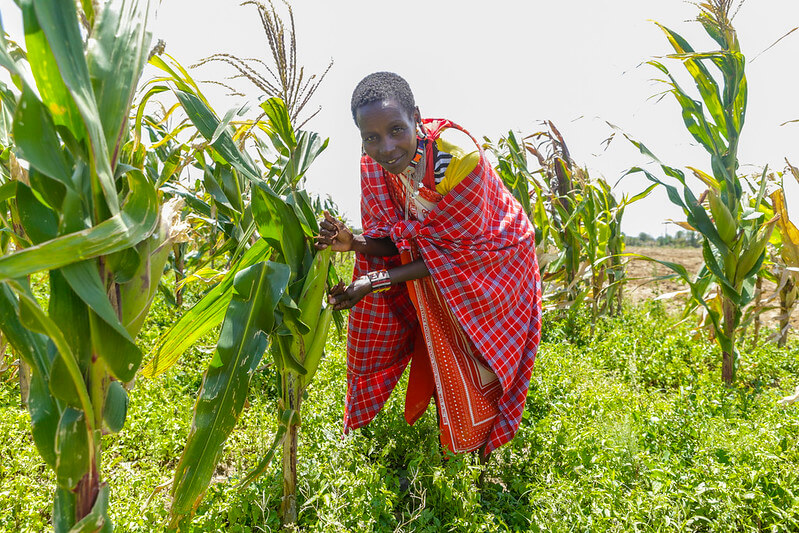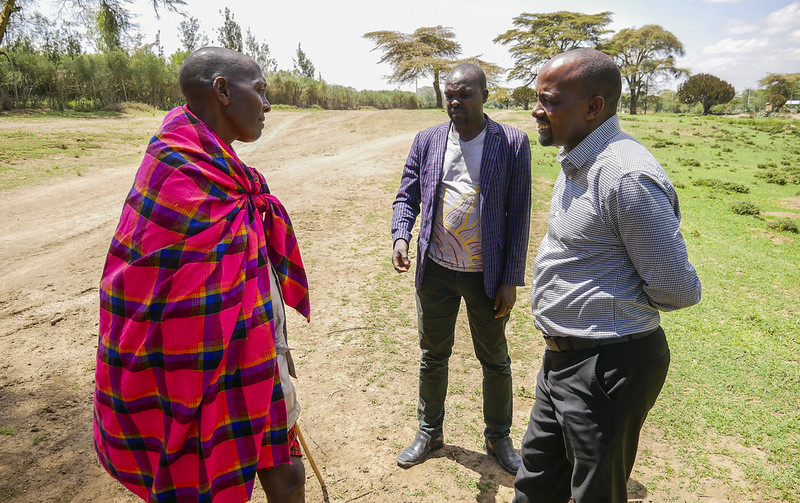Kenya
Managing Forests through Community Participation
Communities need to be involved in order to have a successful project.
“It’s always better to involve us,” “Even though I cannot read or write, I know what I need for my family to live. We need healthcare and water.”
Kibarisho Leintoi
a 36-year-old Masai mother of eight children.
Kibarisho needs water for the irrigation of her tomato farm and for her five goats and five cows. Without water, her income shrinks.
She used to have the means to send two of her children to school. But after a crop failure due to drought, one of those two children had to drop out when she couldn’t afford the fees.
In the past, a little water well would have sufficed for the community. But due to increasing population and livestock pressure, this is no longer sufficient. The people of the Maji Moto community, who live near Narok County in Kenya, soon realized that a dam would be necessary to help them collect enough water for irrigation and livestock.
The community selected a committee of seven people, among them Kibarisho Leintoi. The committee met with Indigenous Livelihood Enhancement Partners (ILEPA), an indigenous people’s organization that has been working to help established communities identify and prioritize their needs. When the Maji Moto community told ILEPA that they needed a dam, ILEPA trained the community in proposal writing and helped them find a sponsor. The funds were then overseen by the community after receiving training from ILEPA on how to monitor and handle the funds.
Indigenous Peoples (IPs) have implement projects and take ownership
ILEPA showcased that Indigenous Peoples (IPs) have the capacity to implement projects and take ownership, with the right training and capacity building.
After working with communities for many years, ILEPA won the United Nations Development Programme (UNDP)’s tender to develop stakeholder engagement and Free Prior and Informed Consent guidelines and toolkits, which will help donors and governments to involve communities when setting up projects that affect their livelihoods.
"It is important to know who to talk to in the community because in the Masai community, for example, you have a cultural leadership, as well as an administrative leadership,” “The constitution spells out that in projects affecting their livelihoods, citizens should be involved.”
James Twala
Program Officer on Climate Change for ILEPA


Indeed, in 2010, Kenya adopted a constitution that has had profound consequences on how natural resources, including forests, are managed. Governance over natural resources is shared between the national and county level governments. The constitution requires public participation in the management, protection and conservation of the forests. Consequently, various legislation, such as the Forest Management and Conservation Act 2016 and the Climate Change Act 2016, targets the implementation of climate change processes and engagement of local communities and minorities in environmental protection and monitoring, as well as benefit-sharing.
“We are not making new laws, but making sure that Free Prior Informed Consent (FPIC) is respected,” says Twala. “Because when projects are community-driven, people feel ownership and the project has a better chance for longevity since the community feels personally and collectively responsible for taking good care of it and maintaining it long after the donor has left.”
The guidelines developed by ILEPA include consultative meetings where people express their needs and the community is informed of the details of the project, including costs. Then the community decides if they give their consent or not, and if they do, community leaders have the option of giving consent verbally, or signing the agreement. This consent articulates what exactly will happen, the timeline and the outcome. Lastly, the community and the implementing entity is responsible for monitoring the implementation of the project.
Ensure that FPIC is part of Kenya’s forest policies
Since 2017, UNDP has been the delivery partner for Forest Carbon Partnership Facility (FCPF) and, together with the Kenyan Ministry of Environment and Forestry, applied these guidelines in the development of the project document. During this process, stakeholders recommended a review of forest policy and legislation in Kenya to include the application of these guidelines as part of the REDD+ readiness process. This forest policy review has been initiated and is still ongoing to ensure that FPIC is part of Kenya’s forest policies.
Working jointly with KFS, the CFA has set up a management plan with 17 user rights for the members of the CFA. Members also have access to the forest for firewood, beekeeping, collecting herbs, medicines, wild mushrooms and other vegetables and forest fruits, water, fodder for their cattle and humus for nurturing their seedlings at home. This successful “shamba system” has been in place since 2010.
“Local communities have to be involved in decisions about forests that affect their livelihoods.” She set up a Community Forest Association (CFA) and asked the Kenya Forest Service (KFS) to give each member half an acre of land and tree seedlings to plant alongside their own crops. Members would then return these plots after the trees grew for three years.
Tecla Chumba
A Kenyan woman from the Lembus tribe and a mother of four
Working jointly with KFS, the CFA has set up a management plan with 17 user rights for the members of the CFA. Members also have access to the forest for firewood, beekeeping, collecting herbs, medicines, wild mushrooms and other vegetables and forest fruits, water, fodder for their cattle and humus for nurturing their seedlings at home. This successful “shamba system” has been in place since 2010.
The “shamba system” or Plantations Establishment for Livelihood Improvement Scheme (PELIS)
This is called the “shamba system” or Plantations Establishment for Livelihood Improvement Scheme (PELIS). It is a way to afforest land where exotic trees have been cut for timber. The community benefits from being able to plant crops such as potatoes, tomatoes, beans, peas, maize and even grass for cow fodder, in exchange for planting tree seedlings and taking care of them for at least three years. This agroforestry approach has set the expectation for local farmers to use traditional indigenous methods to kill insects. Instead of insecticides, they use cow dung and ashes. In return, KFS gets a piece of land that has been reforested.
While public participation has been laid out in various legislations in Kenya, in the beginning, the rules on stakeholder participation, including indigenous peoples, were not very clear about how to participate in decision-making in the forestry sector.
The Kenyan Forest Management and Conservation Act 2016 says that KFS has to respect public participation
But when the KFS advertised that they were leasing the land to a company interested in planting and harvesting trees, denying the CFA the right to do PELIS, Chumba, together with the National Alliance of Community Forests Associations Kenya (NACOFA), took the KFS to court. Because the CFAs had a signed management agreement with the KFS, NACOFA won the case. “The Kenyan Forest Management and Conservation Act 2016 says that KFS has to respect public participation,” says Chumba.
“Stakeholder engagement guidelines and FPIC rules were developed with support from the Ministry of Environment and Forestry as part of UN-REDD Programme’s targeted support to Kenya through UNDP,” “It gives an opportunity for communities to participate in the decision-making processes on projects regarding the forests that their livelihoods depend on.”
Judy Ndichu
Technical Coordinator for the FCPF
After they won the case in 2013, Chumba continued the “shamba system” with great success. It exists all over Kenya now, but some areas have trouble when cattle invade their shambas, though this is getting better. “When cows invade your plot, you can now call the forest guard who will arrest the cows,” she says. “Then the owner will show up to get them back and will pay a fine for the damage that his cattle caused.”
She appreciates that CFAs are part of the REDD+ movement, as she believes it is the right way forward. “Indigenous trees are important. They bring the water back; they attract bees; and, they fight against siltation in the water catchment areas. So we are happy to plant them and look after them, especially if we can get carbon credits in return.”
“The UN-REDD Programme has been a pioneer of innovative policies that value and protect forests and their social and ecosystem services. Commitments to human rights-based approaches, social inclusion and stakeholder engagement are vital to its mandate and work,”
Dr. Musonda Mumba
Chief of Terrestrial Ecosystems Unit (TEU) and Chair of the core team preparing the UN Decade on Ecosystem Restoration at UN Environment
Story by: Griet Ingrid Dierckxsens, Africa regional Communications and Knowledge Management specialist for the UN-REDD Programme in Nairobi, Kenya.
Videos and photos by: James Ekwam/UN-REDD

